How Microsoft Created a Revolution in Soviet Computing
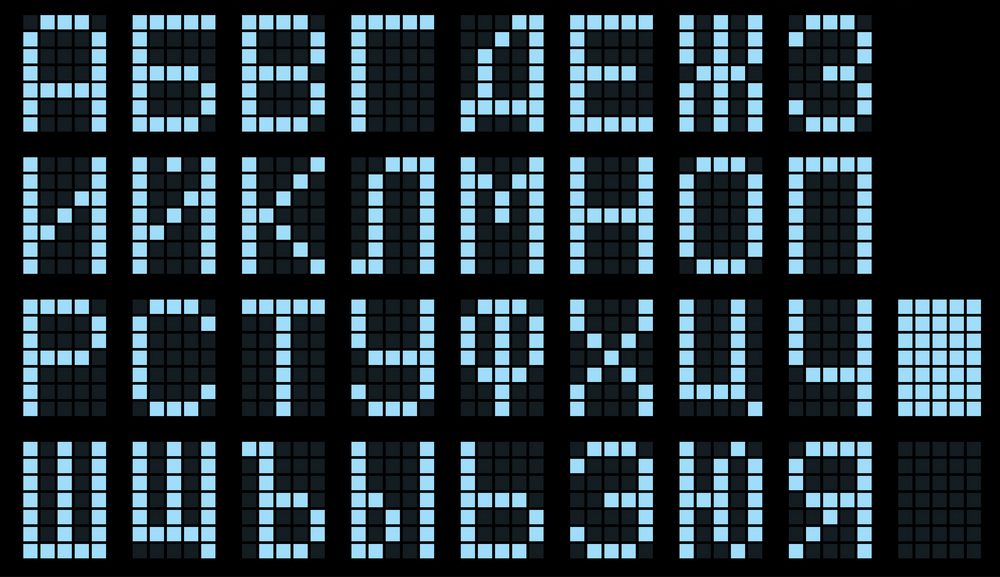
The Cyrillic alphabet, dot matrix-style. (Photo: Albo003/shutterstock.com)
In 1990, as computers started to become a common sight in homes around the United States, a particular problem developed. Call it the QWERTY challenge: What if the keys on your keyboard that you’re familiar with—and have been familiar with for decades—were just gone, and you had no choice but to communicate in another language just to complete basic tasks?
During the early days of computing, this is what the experience was like for a lot of computer users outside of the United States, specifically those that didn’t rely on a romanized alphabet. Certainly, there were a lot of attempts to localize the computing experience and build unique offerings of their own—particularly in Japan, where NEC’s PC-98 platform and Fujitsu’s FM Towns line of PCs were hugely successful during the ‘80s and ‘90s, and in Finland, where Nokia built a line of personal computers before jumping into mobile devices—but these attempts ultimately ran head-first into the idea of globalization. Microsoft and Apple, in the end, were simply too hard to ignore.
Technology firms weren’t always thinking in terms of the rest of the planet as they designed computers, operating systems, and applications that soon became the lingua franca of business and entertainment everywhere. Nowhere, perhaps, was this dichotomy between technology and culture felt more distinctly than in the Soviet Union, where not only was the language a factor, but so was the Cold War.
And as the Cold War thawed, Microsoft was there with a chisel to break the ice.

It was a tiny German offshoot of Microsoft that spearheaded something that would revolutionize the relationship between the U.S. computer industry and the Soviet Union: A plan to fully localize MS-DOS and Microsoft Works for the Russian markets. This was a big deal, as the operating system and application suite, respectively, played key roles in Microsoft’s initial takeover of the world of computers.
The potential upside to doing business inside the Iron Curtain was huge. This was a fairly untapped market that made up a sixth of the world’s land mass at the time, and had a population that nearly matched that of the United States. Soviet computer users of the era, from the top on down, were pirating just about everything. And Microsoft’s did not hide its desire to make nice with America’s Cold War enemy. Bill Gates himself made a visit to Moscow in April of 1990 in an effort to rally the troops.
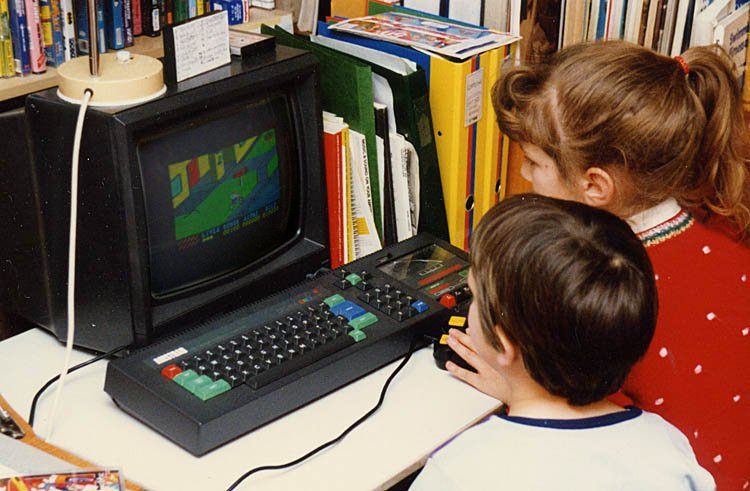
Children playing Amstrad CPC464 computer in 988. Data and programs were input with the built-in tape reader on the right of the keyboard. (Photo: Public Domain/WikiCommons)
The troops that he rallied worked for the Soviet-American joint venture Dialogue (JV Dialogue), an organization set up essentially to connect the U.S. computer industry with Russia’s. The project was daunting. According to Yuri Starikov, who helped manage the JV Dialogue projects, localization was more than just changing a few words here and there.
“This is much more than just a translation of documentations and error messages,” says Starikov, “Localization created new standards and terminology.”
In some ways, this project clashed with Microsoft’s global approach at the time. While the software giant had completed localization projects in the past, the company’s developers of the era—specifically, the ones in Redmond, Washington—freely admit that localization was sort of an afterthought during the ’90s, especially when it came to Windows.
“While the code that was written for the English version was careful to put localizable content in resources, there were often English-specific assumptions hard-coded into the source code,” Microsoft developer Raymond Chen once wrote of the Windows 3.1 era of development. “For example, it may have assumed that the text reading direction was left-to-right or assumed that a single character fit in a single byte.” (The company itself did not wish to comment for this story.)
Problem was, this was easier said than done. There was no standard way of making a computer work in another language at the time. If you wanted to move beyond the standard 26 letters of the Romanic alphabet—as is required when writing in Japanese, Mandarin Chinese, Inuit, or Russian—you basically had to build it from scratch. The Unicode Consortium, which has since sorted all this stuff out, didn’t come along until a few years later.
Manufacturers and developers around the world were essentially creating the script, and the Soviet Union was no exception.

“The Soviet applications software industry is and has always been a shambles. Indeed, it does not deserve to be called an ‘industry.’ This sorry state of affairs is entirely obvious to both users and industry leaders but, to date, Soviet policy makers have been unable to deal effectively with it.”
That line, from a 1989 Hudson Institute report about state of Soviet computing, is a pretty blunt but accurate take on the industry, highlighting the challenges that faced both the country and outside companies who wanted in.
Piracy was perhaps most famous issue. “Copying is so pervasive that the people over there think that Maxell and Verbatim, the floppy disk makers, are actually the software publishers,” Larry Heimendinger, then the president of the Nantucket Corporation, quipped in comments to The New York Times in 1991.
But the real problem for Russian computer users was the hardware. There were a lot of reasons for this, some of them diplomatic in nature. The Coordinating Committee for Multilateral Export Controls, a coalition of 17 Western countries, greatly limited the number of computers that could be sold in the Eastern Bloc. Until the early ’90s, the coalition limited access to Intel’s most popular processors, along with networking equipment and some of the manufacturing tools needed to build computers. That made entering the market a no-go for many of the world’s biggest tech players.
The limited access to hardware mostly kept Russia out of the PC revolution until the late ’80s, Starikov noted, until the creation of the ES-1840, an IBM clone released by the Minsk Computer Technology Production Association (MPOVT) in 1986. These cloned computers were common then, but are obscure now, and faded out of view by the early ’90s.
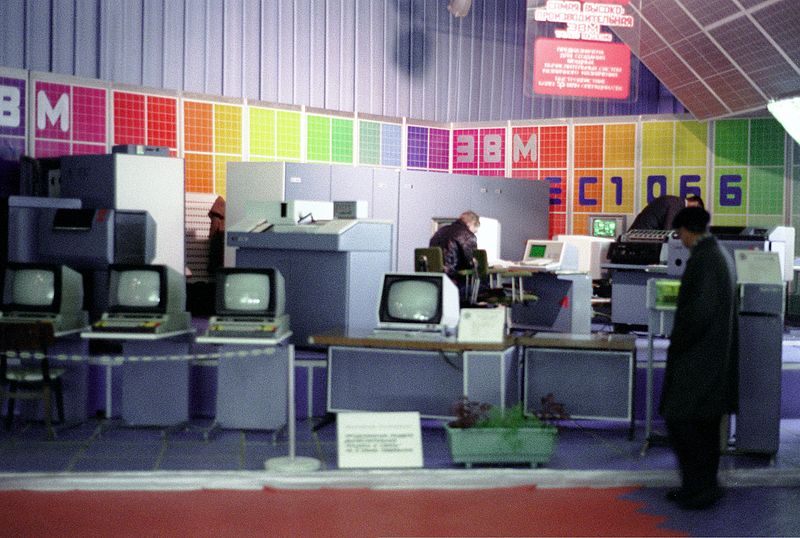
A view of word processors on display at one of the pavilions at the Exhibition of Achievements of the National Economy, Moscow, 1985. (Photo: Public Domain/WikiCommons)
“However, none of the components were manufactured in the Soviet Union: no floppies, no hard drives, no monitors and printers—nothing!” he said.
Had Microsoft chosen not to step in with its own attempts to give Russian consumers legal versions of its operating systems, the Russian computing industry may have been forced to create its own path onto the information superhighway.
There had been numerous attempts to localize DOS in the 1980s, such as АДОС. That software, also known as Alpha-DOS, was a government-built clone that was written to be compatible with MS-DOS 3.2. But these localized versions of DOS represented something of a half-solution, with commands entered in a mishmash of English and Russian.
On top of that, Starikov noted, the underlying source code was clearly ripped off from MS-DOS.
“I met the chief engineer of the Minsk Computer plant who showed me Alpha-DOS—the Russian operating system. He said it is compatible with MS-DOS,” he explained, “I immediately showed him the line ‘Copyright Microsoft Corporation,’ which was placed inside of the one of the most important components of ‘Alpha DOS,’ proving that the ‘Alpha DOS’ is a pirated program.”
The term “mishmash” was also an accurate descriptor for the Russian software industry as a whole.
“Little effort is made toward standardization, and software support and development is done only at the behest of the individual user. There are no Digital Research or Microsoft equivalents in the Soviet computer world,” the Hudson Institute report noted.

The influence Microsoft had on the computer industry in Russia can best be highlighted by the key layout found on most Russian keyboards today—and how much that layout differs from what you can find on mechanical typewriters from decades before.
These keyboards were adapted to Microsoft’s needs—not the other way around. For example, the “Ц” character, once next to the numbers on the right side of the keyboard, was sharing the W key in Microsoft’s layout. And since Russian has so many more letters (33) than English (26), that meant a lot cramming characters any-which-way. As a result, keys generally relegated to punctuation characters such as brackets now have to do triple-duty, sharing the space with “Ъ” and “Ю.”
Perhaps the most frustrating change is the necessity to hit the shift button to make a comma on a Russian keyboard, something that would probably drive this writer crazy.
Beyond this, there were many technical issues that needed to be dealt with. The Byelorussian Soviet Socialist Republic, now known as the Republic of Belarus, required a keyboard layout of its own. And Ukraine wasn’t able to type the letter “Ґ” (called “Ghe with upturn” in the Unicode spec) until Microsoft stepped in to help.
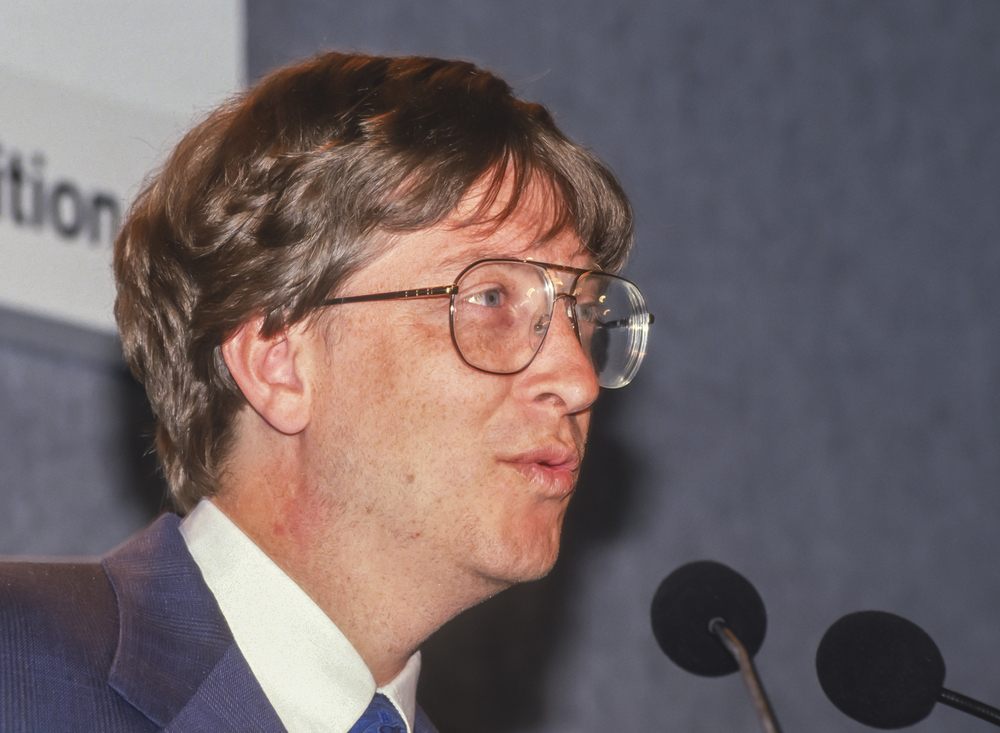
Bill Gates in 1993. (Photo: Rob Crandall/shutterstock.com)
In building the translation of DOS, the team based its work on a Russian-built variation of the IBM PC’s keyboard scan code table. The translation was built by a team at the USSR Academy of Science’s Computer Center. The code table, basically a table of contents for characters that appear on-screen, was built to be largely compatible with most Western software—a key issue for JV Dialogue team.
The resulting character codes JV Dialogue used, and while not exactly the same as what the academy came up with, were more visually appealing than an existing setup created by IBM.
The process of displaying these keys on a computer screen required the creation of new drivers for various monitor resolutions—not an easy task in the early 1990s, when “plug and play” was a mere aspiration, rather than a standard feature. On top of this, the team at times struggled to explain the necessity of certain changes to the bosses in Redmond.
But the localization work Starikov and others went beyond Russia and influenced Microsoft’s product line; for example, code from a display driver from one of the team’s developers wrote made its way into the American version of MS-DOS 5.0, and Windows 3.1 had better support for extended characters partly because of Starikov’s work.
It was an impressive amount of technical work lot of work for an untested product made for a barely open market. It’s a sign of Microsoft’s commitment to the project that they sent the CEO to personally appeal to the Soviet people.

Gates has made a handful of visits to Mother Russia, most recently in 2007, but his 1990 visit was perhaps his most influential and least-heralded. Few stories about the trip exist, but his work helped to set the stage for Microsoft’s long-lasting takeover of the Russian market, and built relationships with Russian developers.
An undercurrent of Gates’ visit was an effort to legitimize the company in the eyes of Russian computer users at a time when piracy controlled the market—which is to say that the only real competition that Microsoft had on the operating system front was from pirated copies of its own software. Esther Dyson, one of the few Western journalists to cover Gates’ first visit to Eastern Europe, suggested that Microsoft’s decision to introduce DOS to the market represented an effort to simply give users a legitimate option.

Cold War-era home computing: a running workplace for the East German home computer Robotron KC 85/1, with cassette deck Geracord 6020 Portable, dot matrix printer Robotron K 6313 and Russian Junost-402B television set. (Photo: Hans Wollny/WikiCommons)
“PCs imported from Western firms tend to include legitimate OEM copies of DOS, but those built by government organizations or imported from non-CoCom countries tend not to,” Dyson wrote in May 1990 in a now-defunct magazine called Release 1.0, “Marketing is a question of persuading people who are already using your product to pay for it.”
(She added that, when Gates was asked how he intended people to actually pay for the software, considering it wasn’t being sold in local currency, he struggled with an answer.)
Microsoft attempted to take on the rise of piracy through the use of a warning screen embedded into every copy of the localized version of MS-DOS 4.01. Unfortunately, their attempt to curb the behavior had its own issues.
“For this screen, we needed to add a specific driver for loading [the font onto the] video card, otherwise the text was unreadable,” Starikov explained, “This screen required [the] pressing of any key to continue the boot of MS-DOS. This created some problems for automation using Russian MS-DOS 4.01.”
The blunt warning was ultimately short-lived, as it proved ineffective. A technically inclined user found a way around it, a muted warning was included in the Russian version of Works, and the translated version of MS-DOS 5.0 ultimately did away with it.

So where was Apple during all of this? While Microsoft was attempting to convince people that its software was worth paying for, longtime competitor Apple stayed away. Even that ultimate act of love, the creation of clones by Soviet users in the 1980s, failed to move the company.
The Agat, an Apple II-compatible machine complete with Cyrillic keyboard, was one such clone. Bright orange in color and featuring custom-built keyboard, the machine was such a direct riff that it contained Steve Wozniak’s name inside of its read-only memory. The prominent American magazine BYTE dismissed it as a “bad copy,” but like the Apple II in the U.S., it became a staple in Russian schools.

A Soviet Delta-C personal computer, ZX Spectrum+ clone. (Photo: Vitaly/WikiCommons CC BY-SA 3.0)
John Sculley, who served as Apple’s CEO for nearly a decade, visited Moscow in 1988 with a number of Apple executives, but at the time demurred from pushing the Macintosh into the market, instead pushing the lower-powered Apple IIgs.
“I think they are very interested in buying Macintoshes. The problem is they don’t have any hard currency to buy them with. And they’d like to manufacture them there as well, and there’s no infrastructure to manufacture them,” Sculley said in a San Jose Mercury News interview that year.
For years, the company circled the market, only taking baby steps. At one point, Sculley gave Mikhail Gorbachev a Mac, but was also quoted in The New York Times in 1990 as saying that the country’s infrastructure wasn’t up to snuff.
“Basic services that business people need—telephones, hotels, and airline service—are still very poor,” Sculley said. “Without telephones and fax machines, we can’t do business.”
By waiting, Apple missed an opportunity to take advantage of an early advantage it had on the localization front: The Unicode Consortium, which officially started in 1991, came about as a result of early collaborations between Apple and Xerox employees. Essentially, had Apple figured out how to sell the thing, it likely could have entered the Russian market with a technology advantage. Alas, it didn’t.
When Apple finally did enter the Russian market in 1993, it used the marketing-heavy strategy that served as its American calling card. In particular, Apple’s iconic “1984” ad, directed by Ridley Scott, aired for just the second time ever on Russian television screens.
The strategy was effectively the same as the United States—show off an awesome product, market effectively, and the sales will start pouring in.
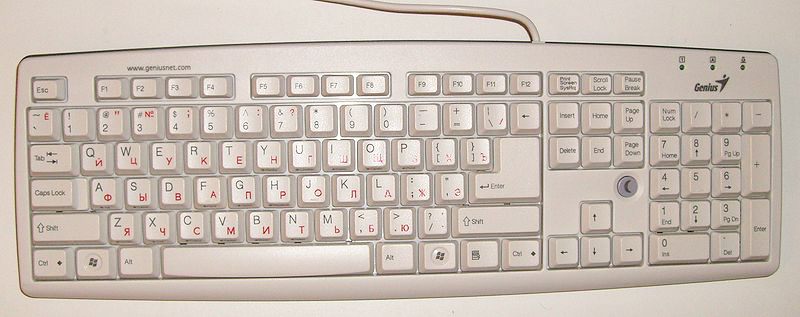
A Russian keyboard from 2009. (Photo: Public Domain/WikiCommons)
Much like in the U.S., this strategy created partisans—for example, there’s an elaborate Apple Computer museum in Moscow containing fairly obscure Apple products like the Apple G4 Cube, the Apple QuickTake 200 digital camera, and the Macintosh XL. Current Russian Prime Minister Dmitry Medvedev is said to be Apple’s biggest Russian fan, to the point where he left condolences for Steve Jobs after the former Apple CEO died in 2011.
But the company remains something of a bit player on the broader scale. According to statistics from StatCounter, OS X currently represents 4 percent of Russian desktop web usage, a percentage dwarfed by every recent version of Windows and far below the 18 percent market share the operating system claims in the United States. Five years ago, OS X represented slightly more than 1 percent of the Russian market.
While iOS does better than OS X in Russia, things have been shaky on that front, too, due in part to recent economic sanctions put in place by the U.S. government, in response to the country’s recent actions in Ukraine, and Apple’s own decision to stop selling its products to Russian consumers online thanks to the ruble’s shakiness. StatCounter notes that iOS’ share of browser usage among smartphone owners fell significantly with Russian users this year, from 45 percent of usage to 34 percent.

These days, computing in Russian is a lot easier. Unicode sussed out the standards, and while Russian computer users have differing preferences from the Western world, it’s largely painless to use a computer in Russia to communicate. Paul Gorodyansky, the creator of the Russian-language Windows resource WinRus and an expert in software localization, notes that with early versions of Windows, reading Russian type was often a problem, especially for people with Western versions of the operating system. Back then, users often needed to download dedicated fonts just to read text in Russian.
The problem at this juncture is less about reading and more about writing, especially when using a Western keyboard.

A typewriter with Russian language layout. (Photo: Public Domain/WikiCommons)
“Many people still don’t know how to type Russian letters—in MS Word, text editor, in e-mail, on a Web site,” Gorodyansky told me.
As a result, one of Gorodyansky’s most popular online offerings is a software keyboard built for typing in Russian. The website offers a variety of Cyrillic layouts in Russian and Ukrainian, as well as phonetic layouts which tend to be popular with users who don’t hail from Russia.
He says that many of the users of his resources are often Russian expats using the Westernized version of Windows, or linguists looking to better understand the Russian language—people who give his offering good reviews.
It also helped set the stage for Yuri Starikov’s career. After finishing his work on localizing Microsoft Works, he was offered a job by Microsoft, where he spent nearly two decades on the payroll, assisting with—among other things—the Russian translation of Windows 3.1. These days, Starikov works with the security firm Spyrus.

Tanks in Moscow’s Red Square during the 1991 coup e’tat. (Photo: Public Domain/WikiCommons)
Differences linger between cultures, but for the most part, the building blocks of connectivity between East and West may have been forged with the help of a crack programming team that, through the process of building drivers and mashing together code, brought the world a little bit closer. One of the side effects, for instance, of Microsoft forcing its way into the Russian market was that the KGB began to lose its grip on communications. According to Starikov, products like typewriters and printers used on devices like mainframes and mini-computers were very easy to monitor. Computers with connected printers en masse—not so much.
The building blocks are often where revolutions get started.








Follow us on Twitter to get the latest on the world's hidden wonders.
Like us on Facebook to get the latest on the world's hidden wonders.
Follow us on Twitter Like us on Facebook